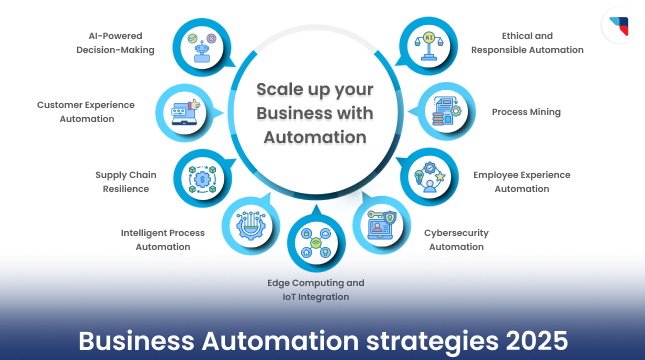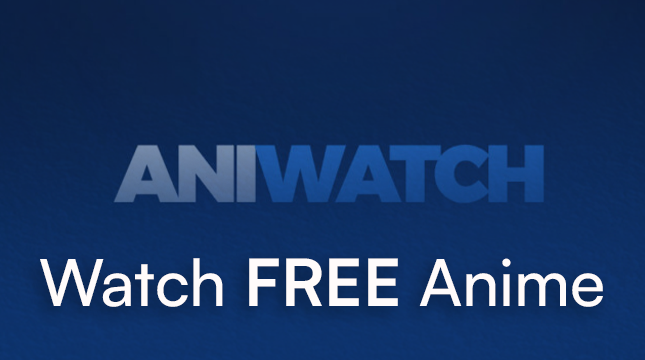This website uses cookies so that we can provide you with the best user experience possible. Cookie information is stored in your browser and performs functions such as recognising you when you return to our website and helping our team to understand which sections of the website you find most interesting and useful.
10 Ways Automation Can Boost Your Business Efficiency in 2025

The advent of automation has largely been made possible by AI. Artificial Intelligence has been the turning point, giving rise to countless business automation strategies. Today, these strategies have become ingrained in business operations, and businesses can’t do without them. Whether it’s a smart mobile app for healthcare data tracking and services or a marketing automation app, avoiding smart technology is impossible.
This blog details ten efficiency-boosting business automation strategies with examples highlighting why you can’t ignore them.
Why Automation Makes a Difference in 2025
Automation was a revolutionary technology when it first came out. In the years leading up to 2025, businesses have studied AI and its capabilities.
This enables the development of custom automation systems appropriate for businesses. Whichever business or automation system you look at, they all have one thing in common. They impart the same benefits:
Improves Productivity: By reducing the number of manual tasks, staff can complete more tasks than before. They can tend to tasks that AI cannot complete, at least not with the required degree of accuracy.
Eliminates Human Error: Automation can solve human error, a major issue that businesses face daily. The immediate and seamless transfer of data across digital systems and applications is a sought-after feature.
Supports Decision-Making: Through automation, business leaders can access data quickly and in a consumable form. This facilitates intelligent decision-making as all the information is available in real-time.
Reduces Costs: Businesses can reduce the number of staff and time spent on manual tasks with automation. It results in cost savings through lower labor expenses and operational costs.
All the above benefits help a business stay competitive. Being among the top contenders in any business niche requires a cost-efficient and productive system.
10 Business Automation Strategies
These ten business automation strategies are bound to help businesses competing in difficult markets.
1. Marketing Automation
Marketing remains a pillar for business operations worldwide. Unfortunately, it takes a lot of time, and exhaustion of ideas can hinder marketing success.
Marketing automation platforms such as Lookinglion.org provide a comprehensive solution. They allow businesses to automate communication with potential customers on various channels.
Various actions they perform are drip sequences, CRM updates, lead scoring, SMS automation, and more.
Example: An e-commerce website can reduce cart abandonment and increase sales by sending out limited-time discounts and cart abandonment emails.
2. Social Media Scheduling & Analytics
Social media has become a priceless asset for businesses in this digital age. Potential customers use social media to discover brands and products. They also use it to seek genuine reviews about them and gauge value for money.
Several social media tools exist, making posting and even content creation simpler and faster. It allows businesses to schedule posts for maximum engagement in other countries with large time-zone differences.
Example: Businesses can maintain posting timing and automate posting across platforms to free up staff time. It gives social media staff more time to focus on creating valuable and engaging content.
3. Task & Workflow Automation
Automating manual tasks, especially those that repeat multiple times a day, saves time. Zapier, an automation tool, is the top task and workflow automation tool for businesses.
The tool connects various applications to automate various workflows. It works to reduce staff workload and save time by automating lengthy tasks that are prone to human error.
Example: Employing multiple task automation tools can be time-saving, leading businesses to save dozens of hours a week across departments.
4. CRM Automation
Organizing customer information, improving customer experience, and optimizing business processes is possible using Customer Relationship Management (CRM) software.
HubSpot, a prominent CRM automation tool, shows how customer data, preferences, and order details can be aligned with marketing and sales efforts. It’s a way for companies to get insight into the changing consumer demands and can help improve customer support.
Example: A subscription-based firm converts 80% more recurring customers by sending automatic reminders.
5. AI-Driven Customer Support
Chatbots have become a staple customer support option for both large and small businesses. These intelligent AI-driven applications can deliver customized responses using the data they’ve been trained on.
This has changed business-customer relationships and also improved business opportunities. This helps firms address customer queries quickly, improve lead conversions, and reduce dependence on human customer support.
Example: Businesses in niches like Banking and Finance can solve customer queries through website chatbots or WhatsApp chatbots.
6. Accounting/Bookkeeping Automation
Automation’s greatest application in finance is to eliminate data irregularities and prevent miscalculations.
This software has also become one of the IT innovations transforming the Insurance and Finance sectors. These tools are part of business automation strategies that directly link accounting applications to businesses, reducing data transfer errors and delays.
Example: An accounting business can reduce accounting and invoice errors by 90% with a reliable accounting automation tool.
7. Supply Chain Automation
Manufacturing companies utilize AI and automation in various aspects. It facilitates smoother operations by anticipating demand and delivery route complications. Supply chain automation manages inventory and ensures production meets the market demand.
Example: Shops can use a supply chain automation tool to check stock levels, predict high-demand timings, and prepare appropriately. It can identify the least popular products, allowing the store to adjust prices to clear this inventory.
8. Recruitment & Onboarding Automation
Recruitment processes have become quicker and more trackable with AI recruitment and onboarding software.
Some software tools even have a resume grader that intelligently scans for specific keywords. ATS, or Application Tracking Software, allows the HR department to track candidates and their applications. This software helps firms manage recruitment activities using a unified dashboard.
Netizens Technologies can develop a similar platform for your business with our custom software development services.
Example: IT firms can speed up hiring times from months to weeks, ensuring projects aren’t delayed.
9. Productivity Tracking
Ensuring all work is accounted for and being undertaken is possible with productivity tracking. These platforms ensure maximum productivity and also help IT companies that charge clients by the hour. It’s why they’re one of the top business automation strategies.
Productivity tracking, such as Asana, will help in project management, organization, and collaboration. Such tools have become the standard for large enterprise businesses seeking to optimize productivity.
Example: A business can track work and ensure deadlines are met through planning, collaboration, and project management.
10. Document Management & e-Signatures
These applications facilitate documentation and form-filling. It enables the filling of forms, storage, and transfer from the business to clients and vice versa.
Cloud storage applications and PDF file editing applications are two types of document management software that are widely used.
Example: Real estate agents can close more deals in a shorter time frame with paperwork that can be digitally signed and sent back.
Conclusion
IT solutions are making business easier and more efficient. It’s up to businesses to apply these technologies correctly to seek the rewards. IT solutions for restaurants, event management, healthcare, and manufacturing are saving businesses time and money. If you’re business isn’t using efficiency-boosting business automation strategies, you’re missing out.
Developing your own version of these systems is possible by partnering with Netizens Technologies, an expert in software development and mobile app development.
FAQs
1. Why are business automation strategies necessary?
These strategies are necessary in today’s digital world. Companies must employ strategies to become better and compete with other companies.
2. What is the difference between AI and business automation?
Business automation is technology that performs repetitive tasks without human intervention. Artificial intelligence is a computing system that performs tasks that would otherwise require human intelligence.
3. Which business process is best suited for automation?
Many processes will benefit from having automation. The best examples include customer support, logistics, marketing, and task management.
4. What is the primary goal of business process automation?
Business automation strategies will aim to improve workload, increase productivity, and reduce costs. This makes the primary goal of this process to increase profits.
5. How to create an automation strategy?
Businesses should start by identifying the problems or repetitive tasks across departments. They should then see which tasks can be automated or how processes can be improved. Then look for automation solutions or hire an IT partner to build a new solution.

Let's Start Your Project
Get free consultation for your digital product idea to turn it into reality!
Get Started







